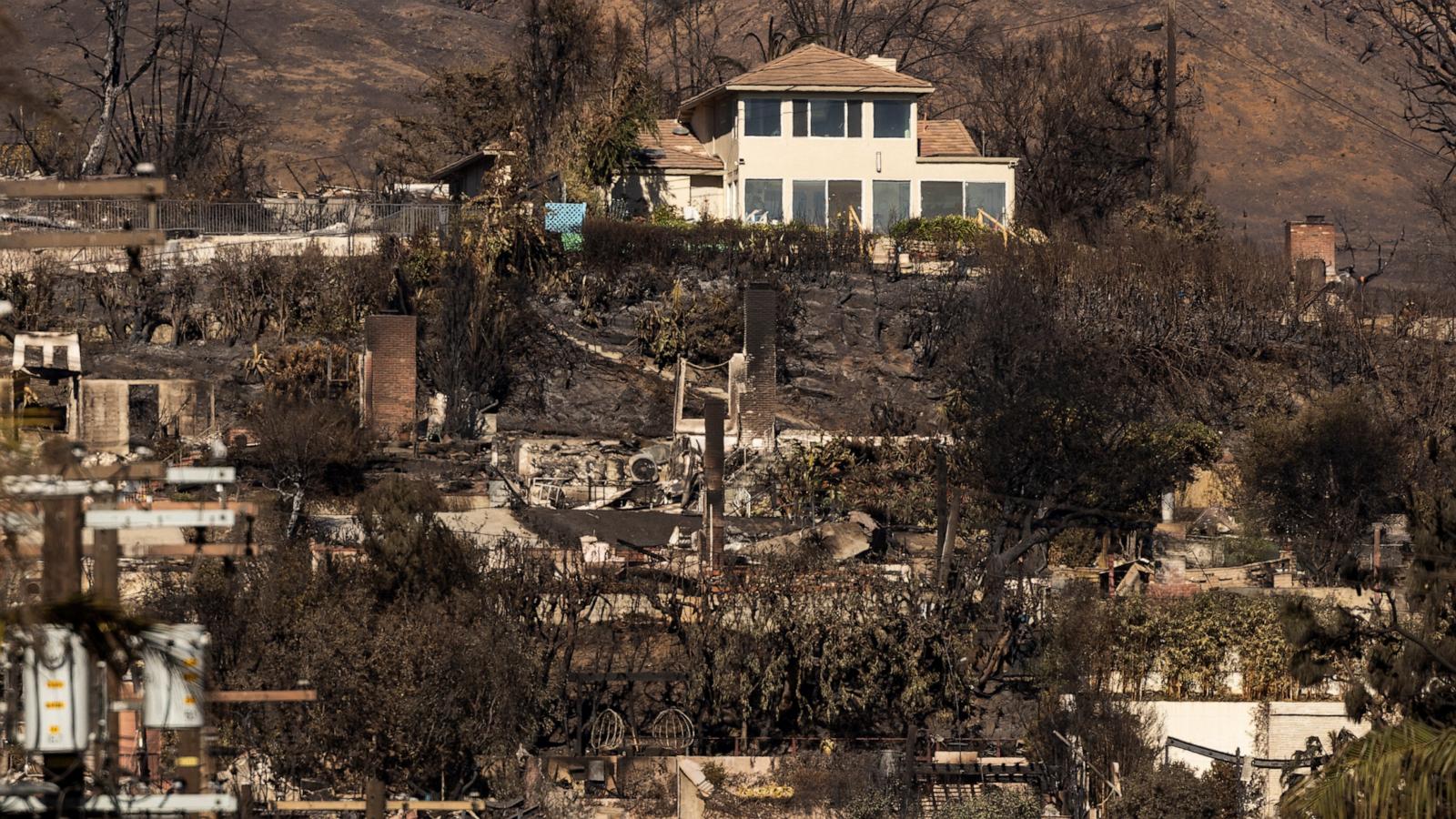The Los Angeles wildfires have reduced entire communities to ash, prompting some of those who lost their homes to vow to rebuild in the same spot they called home.
But destruction at this scale will be no easy feat to clear or reconstruct, experts told ABC News. Challenges in debris cleanup, neighborhood planning and even the emotional health of the communities who were impacted by the fire could be prominent features of the rebuilding effort.

The wildfires aren’t even close to being contained. While winds began to die down on Thursday, offshore Santa Ana winds could return next week, bringing back dangerous fire conditions in an already charred region.
While the desire to rebuild may be fervent, the logistics surrounding the placement of homes, what they’re constructed of and the reality of living on potentially uninsurable land could hamper efforts, the experts said.
Here are some of the challenges that rebuilding in fire-torn Los Angeles could present.
Cleanup will take years
The massive amounts of debris are going to be difficult to clean up because of the topography of the land as well as the sheer amount of toxic materials that need to be collected, the experts said.

In places like the Pacific Palisades, one of the hardest-hit neighborhoods nestled into the foothills of the Santa Monica Mountains, the terrain will make it challenging for cleanup crews to operate, Deborah Sivas, a professor at Stanford Law School who specializes in environmental law, told ABC News.
“It’s not like a big, flat city block and [crews can] go bulldoze the whole thing,” she said.

On Wednesday, the Los Angeles County health officer issued an order to ensure the safe removal, transport and disposal of fire debris resulting from the wildfires.
“This order aims to protect public health and safety during the cleanup process for fire debris,” states a press release from the Los Angeles County Department of Public Health.
Water quality could be impacted
The infrastructure of crucial utilities like water could be impacted, the experts said.
When houses are burned down and plumbing fixtures are lost, there is effectively a loss in the pressure in water lines, Thomas Young, a civil and environmental engineering professor at the University of California, Davis, told ABC News.
Young, who has researched other large fires such as the Camp Fire in Paradise, California in 2018 and the Maui wildfires in 2023, said when an entire neighborhood is lost in a fire, the entire water system is likely compromised, he said.
“Any place in the water lines that might have a crack or gap before, which would have had water leaking out, now has the possibility of stuff from the outside getting in,” Young said. “The concern is the ash or other fire debris would be sucked into the lines.”

Debris from the scorched homes near Malibu’s Big Rock will end up in the ocean as well — by wind and sea — due to the proximity to the coastline, said Costas Synolakis, a professor of civil engineering at the University of Southern California, who has studied how urban fires exacerbate post-fire related hazards.
Elsewhere, toxic byproducts created by the fire will seep into the earth and eventually get carried into the watershed by rain, Synolakis told ABC News.

It will probably take months until communities have reliable drinking water again, Young said.
“The environmental impact of those for a fire of this scale, we just don’t know yet,” Synolakis said.
Rebuilding in some of the same spots may difficult
It will likely not be possible to go and rebuild the exact same thing as before, Michele Barbato, a civil and environmental engineering professor at UC Davis who has researched sustainable structural solutions, told ABC News.
“We’ve been building with very little consideration of fire for many decades,” Barbato said. “Rebuilding something that burned down is just not a good idea. If we rebuild exactly as we have and don’t take proper measures, we can only expect the same results, or worse.”
Urban planning will be important going forward because a lot of the communities and where they were situated “weren’t safe to begin with” when taking fire safety into consideration, Scott Stephens, professor of fire science at the University of California, Berkeley, told ABC News.

For homes in the foothills, if a rare wind from the north gets blown down, that’s “basically a death trap” for those homes, Hugh Safford, a research fire ecologist at the University of California, Davis, told ABC News.
While California already has “extremely good” regulations in place for making new housing fire resistant, Synolakis estimates that 90% of the homes that burned down were built before those regulations went into effect, adding that all homes should be retrofitted to meet current building codes.
“Certainly in the lowlands or Palisades, some of the houses are close to 100 years old,” he said, meaning they are made of wood frames and other extremely flammable materials.

The University of California Los Angeles Climate & Wildlife Research Initiative recommended making homes more fire resistant and building new units in low wildfire risk zones in a quick-turn analysis released Tuesday.
In an effort to quantify what contributed to the fire, the climate scientists found that while climate change could be responsible for roughly a quarter of the extreme vegetation dryness present when the Palisades and Eaton fires began, the fires would still have been extreme even without that moisture deficit.
When rebuilding, everything should be built according to Chapter 7A of the California Building Code that is focused on wildfire urban interface construction, Barbato said.
This includes stopping the use of wood for construction and using a noncombustible material instead; ensuring there are no holes are crevices were embers can accumulate; making sure windows have at least a double pane with glass that is tempered to fire, so that it doesn’t shatter; and constructing roofs out of noncombustible materials, Barbato said.
The psychological toll of rebuilding entire communities
The link between psychological trauma and natural disasters has been well-documented.
People who are impacted by natural disaster may feel a strong sense of grief, panic, loss, fear and sadness, according to the University of Houston’s Department of Psychology. According to the American Psychiatric Association, the mental health consequences of single weather-related disasters for most people include mild stress and insomnia, high-risk coping behavior such as increased alcohol use and mental disorders such as depression, anxiety and post-traumatic stress.

Climate disasters bring “crushing stress” to physical, mental and emotional health, Lise Van Susteren, a general and forensic psychiatrist who has researched how climate change impacts mental health, told ABC News. The scale of the devastation in Los Angeles — which has left once-vibrant communities resembling a war zone — is sure to compound the trauma, Van Susteren said.
As a coping mechanism, people’s first line of defense is often a quest to rebuild, Van Susteren said, adding that it’s a way to feel in control of the situation.
“Under stress, we don’t do our best decision-making,” she said. “So we are already at a disadvantage.”

Conversely, there will be many who may not be able to handle the triggers of trying to bring back a community that once was or the possibility that a similar threat could wipe everything away again, Van Susteren said. The community may not be able to return to its former glory, especially if many of the residents leave for good. People may not be able to afford a rebuild, especially if it takes years.
Places impacted by the Paradise Fire in 2018 or the Tubbs Fire in 2017 — where whole neighborhoods burned down — are still not back to normal, Sivas said.
“Just as there are climate tipping points, there are social tipping points,” Van Susteren said.
ABC News: Top Stories
Read the full article .


